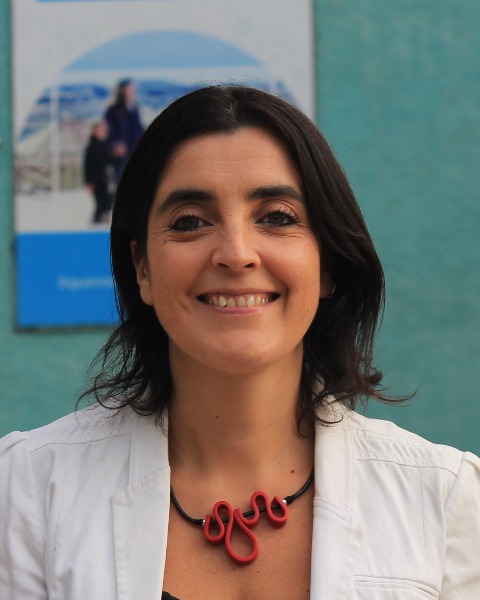Ovary/Oocyte
Poster Session C
(P-315) TRPV3 and Cav3.2 ion Channels Functionally Interacts in Mouse eggs
Friday, July 19, 2024
8:00 AM - 9:45 AM IST
Room: The Forum

Ingrid Carvacho, N/A, Dr.
Assistant Professor
Department of Traslational Medicine, Faculty of Medicine, Universidad Catolica del Maule
Talca, Chile
Poster Presenter(s)
TRPV3 and Cav3.2 ion Channels Functionally Interact in Mouse eggs
Ingrid Carvacho1, Consuelo Henríquez1, Arnaldo Yáñez1,2, Mackarena Mundaca1,3, Mariela González4, Matthias Piesche5, Fernando Hinostroza6, Ariela Vergara-Jaque4
1 Laboratory of Ion Channels and Reproduction, Faculty of Medicine, Universidad Católica del Maule, 3480112 Talca, Chile.
2 School of Engineering in Biotechnology, Facultad de Ciencias Agrarias y Forestales, Universidad Católica del Maule, 3480112 Talca, Chile.
3 School of Biochemistry, Universidad de Talca, 3465548 Talca, Chile.
4 Center for Bioinformatics, Simulation and Modeling (CBSM), Faculty of Engineering, Universidad de Talca, 3465548 Talca, Chile.
5 Department of Preclinical Sciences, Faculty of Medicine, Universidad Católica del Maule, 3480112 Talca, Chile.
6 Centro de Investigación de Estudios Avanzados del Maule, Universidad Católica del Maule, 3480112 Talca, Chile
Oocyte maturation or the acquisition of meiotic competence requires a controlled expression of proteins that supports this process in preparation for fertilization. Both, oocyte maturation and fertilization are determined by a highly regulated ion homeostasis. Several ion channels, regulating diverse cellular processes, have been reported to be expressed in eggs from different species, including mammals. Fertilization starts with the release of the sperm-specific phospholipase (PLC) in the mature oocyte, egg. Ca2+ influx is required to accumulate Ca2+ in the oocyte in preparation for fertilization, as well as to refill its intracellular stores during fertilization, supporting Ca2+ oscillations and egg activation. The egg activation includes the formation of the pronucleus, cortical granule exocytosis, polyspermy blockage, and the completion of meiosis II, between other processes to support the transition to early embryonic development. The voltage-gated activated calcium channel Cav3.2 has been reported to be expressed and contributes to the refilling of the Ca2+ store in preparation for fertilization in mouse eggs. In addition, the transient receptor channel from the subfamily vanilloid, TRPV3, a cationic non-selective channel, has been shown to be expressed in mouse eggs, however, its physiological function is currently unknown. Here, using eggs lacking TRPV3 and Cav3.2 proteins, we evaluate their role in Ca2+ influx and cortical granule distribution.
Methods: Using KO animal models, confocal microscopy, bioinformatics and patch-clamp electrophysiology, we tested the expression and function of TRPV3 and Cav3.2 ion channels in mouse eggs, and evaluated their role in cortical granule dynamics.
Results: Cav3.2 currents at -20 mV are significantly decreased in TRPV3KO eggs (8 pA/pF WT eggs vs. 3,75 pA/pF in TRPV3KO eggs). TRPV3 currents in response to the agonist 2- APB are decreased in Cav3.2KO eggs (41 pA/pF in WT vs. 30,5 pA/pF in Cav3.2KO eggs). TRPV3KO and TKO eggs show an impaired cortical granule distribution, measured as fluorescence intensity of labeled lens culinaris agglutinin, in comparison to WT eggs. Bioinformatics approaches reveal potential sites/residues for physical interaction between Cav3.2 and TRPV3 proteins.
Our results suggest a functional and/or physical interaction of Cav3.2 and TRPV3 that might modulate critical cellular processes as cortical granule distribution, underlying egg-to-embryo transition in mammals.
Acknowledgments: FONDECYT 1221308; FONDEQUIP ANID EQM200122
Ingrid Carvacho1, Consuelo Henríquez1, Arnaldo Yáñez1,2, Mackarena Mundaca1,3, Mariela González4, Matthias Piesche5, Fernando Hinostroza6, Ariela Vergara-Jaque4
1 Laboratory of Ion Channels and Reproduction, Faculty of Medicine, Universidad Católica del Maule, 3480112 Talca, Chile.
2 School of Engineering in Biotechnology, Facultad de Ciencias Agrarias y Forestales, Universidad Católica del Maule, 3480112 Talca, Chile.
3 School of Biochemistry, Universidad de Talca, 3465548 Talca, Chile.
4 Center for Bioinformatics, Simulation and Modeling (CBSM), Faculty of Engineering, Universidad de Talca, 3465548 Talca, Chile.
5 Department of Preclinical Sciences, Faculty of Medicine, Universidad Católica del Maule, 3480112 Talca, Chile.
6 Centro de Investigación de Estudios Avanzados del Maule, Universidad Católica del Maule, 3480112 Talca, Chile
Oocyte maturation or the acquisition of meiotic competence requires a controlled expression of proteins that supports this process in preparation for fertilization. Both, oocyte maturation and fertilization are determined by a highly regulated ion homeostasis. Several ion channels, regulating diverse cellular processes, have been reported to be expressed in eggs from different species, including mammals. Fertilization starts with the release of the sperm-specific phospholipase (PLC) in the mature oocyte, egg. Ca2+ influx is required to accumulate Ca2+ in the oocyte in preparation for fertilization, as well as to refill its intracellular stores during fertilization, supporting Ca2+ oscillations and egg activation. The egg activation includes the formation of the pronucleus, cortical granule exocytosis, polyspermy blockage, and the completion of meiosis II, between other processes to support the transition to early embryonic development. The voltage-gated activated calcium channel Cav3.2 has been reported to be expressed and contributes to the refilling of the Ca2+ store in preparation for fertilization in mouse eggs. In addition, the transient receptor channel from the subfamily vanilloid, TRPV3, a cationic non-selective channel, has been shown to be expressed in mouse eggs, however, its physiological function is currently unknown. Here, using eggs lacking TRPV3 and Cav3.2 proteins, we evaluate their role in Ca2+ influx and cortical granule distribution.
Methods: Using KO animal models, confocal microscopy, bioinformatics and patch-clamp electrophysiology, we tested the expression and function of TRPV3 and Cav3.2 ion channels in mouse eggs, and evaluated their role in cortical granule dynamics.
Results: Cav3.2 currents at -20 mV are significantly decreased in TRPV3KO eggs (8 pA/pF WT eggs vs. 3,75 pA/pF in TRPV3KO eggs). TRPV3 currents in response to the agonist 2- APB are decreased in Cav3.2KO eggs (41 pA/pF in WT vs. 30,5 pA/pF in Cav3.2KO eggs). TRPV3KO and TKO eggs show an impaired cortical granule distribution, measured as fluorescence intensity of labeled lens culinaris agglutinin, in comparison to WT eggs. Bioinformatics approaches reveal potential sites/residues for physical interaction between Cav3.2 and TRPV3 proteins.
Our results suggest a functional and/or physical interaction of Cav3.2 and TRPV3 that might modulate critical cellular processes as cortical granule distribution, underlying egg-to-embryo transition in mammals.
Acknowledgments: FONDECYT 1221308; FONDEQUIP ANID EQM200122
